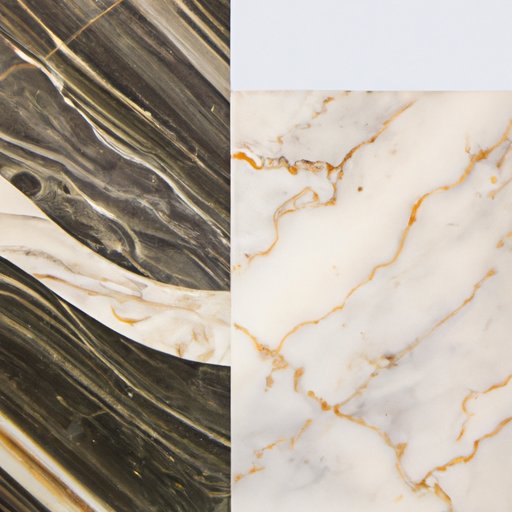Introduction
Cultured marble is a type of composite material typically made from a combination of marble dust, polyester resin, and various pigments. This mixture is then poured into molds to create a wide range of products, including vanity tops, shower pans, tubs, and other bathroom fixtures. It offers homeowners a relatively affordable and attractive alternative to traditional marble or stone.
An In-Depth Look at Cultured Marble
The manufacturing process for cultured marble begins with mixing together marble dust, polyester resin, and pigment. The mixture is then poured into molds and left to cure. During this time, the polyester resin hardens and binds the marble dust together, creating a solid surface. The molds are then heated to further solidify the product. After curing, the pieces are removed from the molds, polished, and inspected for quality control.
There are several types of cultured marble available on the market, including traditional marble, travertine, and onyx. Each type of marble has its own unique look and feel, making it easy to find the perfect material for your project. Additionally, cultured marble can be customized to meet your needs, allowing you to choose from a variety of colors and patterns.

A Guide to Choosing the Right Cultured Marble for Your Home
When selecting a type of cultured marble for your home, there are several factors to consider. You’ll want to think about the overall look and feel of the room where the marble will be installed, as well as your budget. Additionally, it’s important to consider the durability and maintenance requirements of the material. For instance, some types of marble may require more frequent cleaning and sealing than others.
Cultured marble comes in a variety of colors and patterns, making it easy to find the perfect material for your project. You can choose from traditional white marble, as well as more exotic options such as travertine or onyx. Additionally, many manufacturers offer custom colors and patterns so that you can create a truly unique look for your home.
The Pros and Cons of Cultured Marble
Cultured marble has several advantages over traditional stone or marble. It is more affordable than natural stone, easier to install, and requires less maintenance. Additionally, it is non-porous and resistant to stains, making it an ideal choice for bathrooms and kitchens.
However, there are also some drawbacks to using cultured marble. It is not as strong as natural stone, and can be easily damaged if not properly cared for. Additionally, it is prone to cracking and discoloration over time.
How to Care for Cultured Marble
Caring for cultured marble is relatively simple. To keep it looking its best, it is important to clean it regularly with a mild soap and warm water. Avoid abrasive cleaners or harsh chemicals, as these can damage the surface of the marble. Additionally, it is important to avoid exposing the marble to extreme temperatures, as this can cause cracking and discoloration.
Sealing the marble periodically is also recommended. Sealing helps to protect the surface from staining and makes it easier to clean. However, it is important to use the correct sealer for your particular type of marble. Consult the manufacturer’s instructions for more information.

A Comparison of Natural Marble and Cultured Marble
When it comes to comparing natural marble and cultured marble, there are several differences to consider. Natural marble is more expensive, heavier, and more difficult to install than cultured marble. Additionally, it is more porous and prone to staining, requiring regular sealing and maintenance. On the other hand, cultured marble is cheaper, lighter, and easier to install. It is also non-porous and resistant to stains, making it an ideal choice for bathrooms and kitchens.
In terms of physical properties, natural marble is much harder and denser than cultured marble. According to a study published in the International Journal of Scientific & Technology Research, natural marble had a compressive strength of 6.71 MPa, while cultured marble had a compressive strength of 4.44 MPa.
When it comes to price, natural marble is significantly more expensive than cultured marble. The cost of natural marble can vary widely depending on the type and quality of the material, as well as the size and complexity of the project. On the other hand, cultured marble is much more affordable and can be installed for a fraction of the cost of natural marble.

Creative Uses for Cultured Marble
Cultured marble is a versatile material that can be used in a variety of home improvement projects. It is commonly used for countertops, showers, sinks, and floors. It can also be used to create custom fixtures, such as bathtubs, shower pans, and whirlpools.
Cultured marble is an attractive and durable material that is perfect for a variety of home improvement projects. It is easy to install, requires minimal maintenance, and comes in a variety of colors and patterns. Additionally, it is much cheaper than natural marble, making it a great option for budget-conscious homeowners.
Conclusion
Cultured marble is a popular and durable material used in a variety of home improvement projects. It is easy to install, requires minimal maintenance, and is much cheaper than natural marble. Additionally, it is available in a variety of colors and patterns, making it easy to find the perfect material for your project. With proper care and maintenance, cultured marble can provide years of beauty and functionality to any home.
(Note: Is this article not meeting your expectations? Do you have knowledge or insights to share? Unlock new opportunities and expand your reach by joining our authors team. Click Registration to join us and share your expertise with our readers.)
